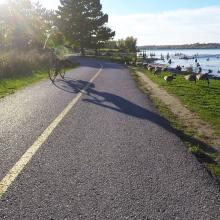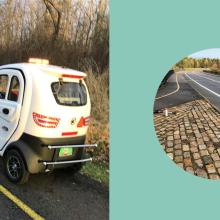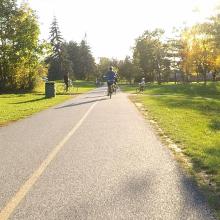Image set

Related services
Related sectors
Related regions
Opening article section
Article section
Rich text
The National Capital Region is home to the Capital Pathway, one of the most extensive trail systems in North America. With over 200 kms of off-road, multi-use pathways, extending from Gatineau Park, through Ottawa–Gatineau and into the Greenbelt, the Capital Pathway safely connects parks, gardens, museums, and attractions.
Providing more than just a fun way to explore the region, the pathway offers critical infrastructure to accommodate thousands to bike, run, jog, walk, etc. as their preferred transportation or recreational activity. Opting to leave the car behind, corridors like the Capital Pathway enable communities to live active lifestyles while curbing emissions.
Maintained by the National Capital Commission (NCC), these pathway systems, like other roadways, need regular maintenance to keep them safe and fully functional. To facilitate repairs, Englobe worked with the NCC to conduct pavement surface evaluations of approximately 11 km of the pathway using our state-of-the-art Electric (EV) Nano technology.
Rich text
Electric (EV) Nano Technology for Pavement Surveys
Custom designed in 2020 by Englobe’s pavement engineering team, the EV Nano is a small electric vehicle used to assess the condition of concrete and asphalt sidewalks and pathway surfaces. It is equipped with a GoPro camera, GPS, an inclinometer, an odometer, and computer to collect data. With impressive built-in technology, the EV-Nano accommodates the growing need for a safe, sustainable, and efficient alternative for assessing small pathways.
The EV Nano was created to fit pathway like the Capital Pathway and is narrow enough to fit into one lane. Its defining feature is that it allows the pathway being assessed to remain open to the public without blocking or creating major disturbance or damage to the green space in the surrounding area. By using this technology, the team ensured that the integrity of the pavement would be properly assessed quickly, safely, and without an impact to the busy traffic corridor.
Media
Image set

Rich text
Making a Community Impact
The greatest impact that transportation projects can have is to seemingly have zero impact at all. Traditionally, a pavement survey for a multi-use pathway or sidewalk involves driving a standard, full-sized work vehicle down the pathway requiring the complete closure of the corridor one segment at a time. This was certainly one of the key achievements for this project. While the team was assessing the pavement for deformations, ruts, cracks, etc., residents and visitors continued to have full, unimpacted use of the trails. Using the EV Nano was unintrusive to the trail and the surrounding greenspace with the bonus of being fully electric.
Sustainable Choices Add-Up
A high-quality network of trails for non-motorized traffic is essential for a modern city and is vital to helping achieve carbon targets the National Capital Region. Having far reaching impacts such as flexibility and mobility of the local workforce, regional development, tourism, and quality of life for residents, high functioning green infrastructure greatly contributes to the social and economic health of a community.
As noted by the NCC, the local multi-use trail system is one of the defining assets of the National Capital Region used by locals and tourists. The pathway, and others like it, are very important to the local community and any issues, including short or long-term closures, that interrupt the daily flow of cycling or pedestrian traffic are a cause for concern to the public at large. Though a pavement assessment project is simple, even small projects help set important precedents for using green technology in lieu of traditional methods.
Article quote
Rich text
Engineering Stronger Communities
The NCC has a responsibility to ensure the Capital Pathway is safe and open for regular use. We all know the frustration associated with potholes, cracks, or ruts in pavement, and the damage that can be caused when neglected. For most of us, we interact with pavement in some capacity every day, yet we are far removed from the specialized engineers who assess, maintain, and design not only these surface environments, but also the technology used to support their upkeep.
Projects like this stand as a reminder that sometimes ‘green engineering’ this starts with something simple like the cycling and pedestrian path’s pavement, and that we do make a difference one project at a time.
Media
Image set
